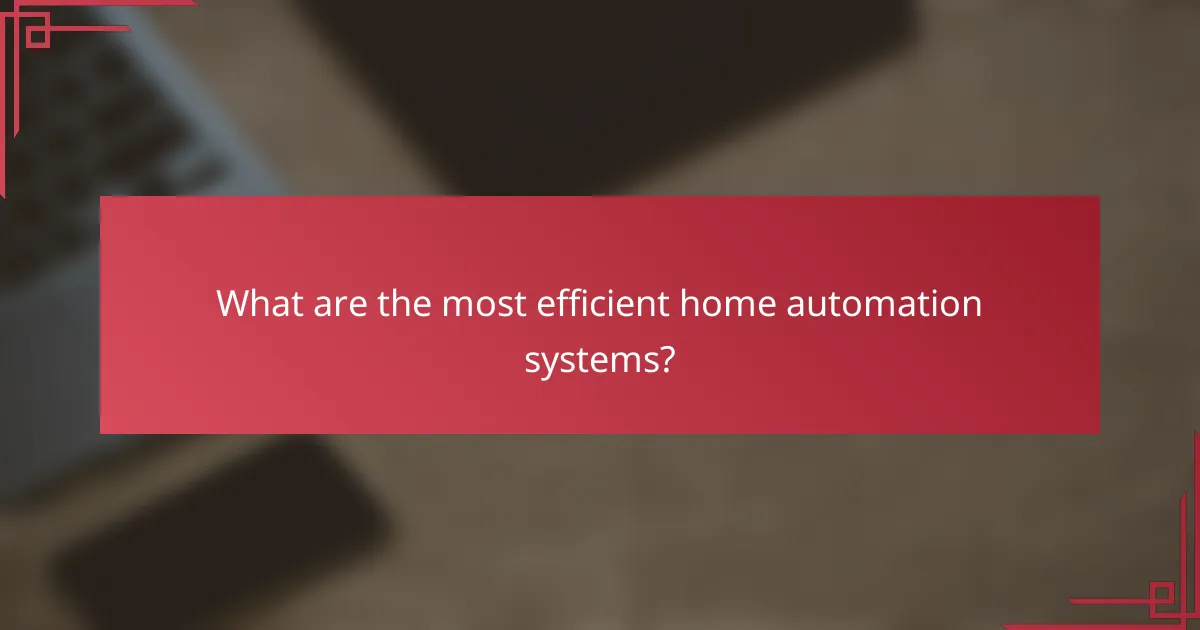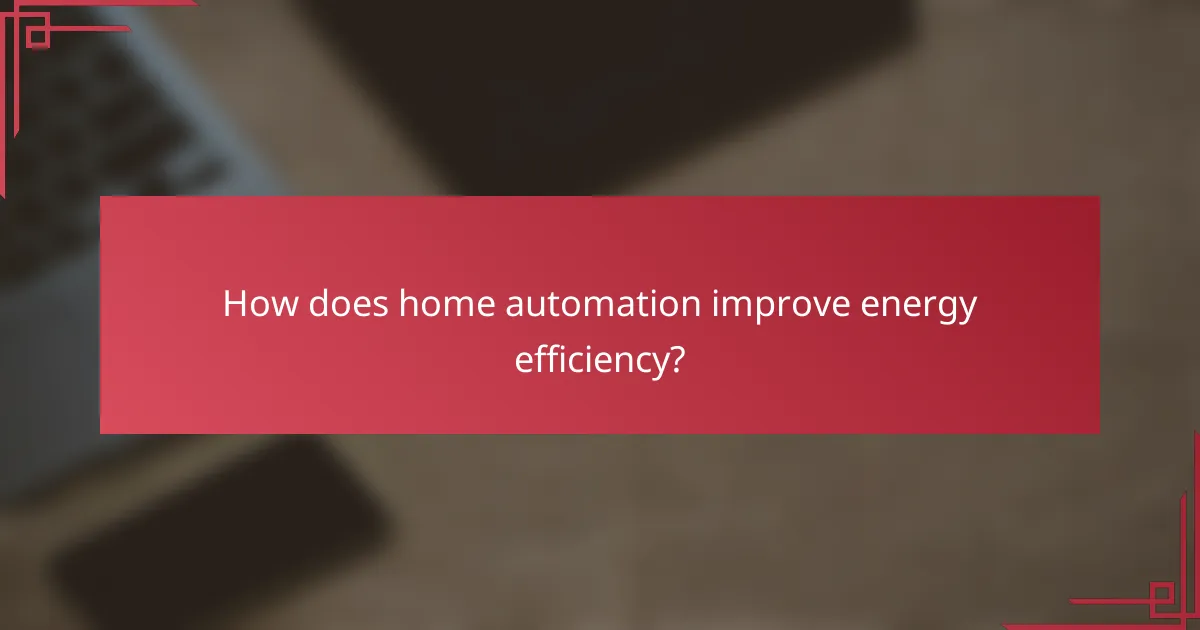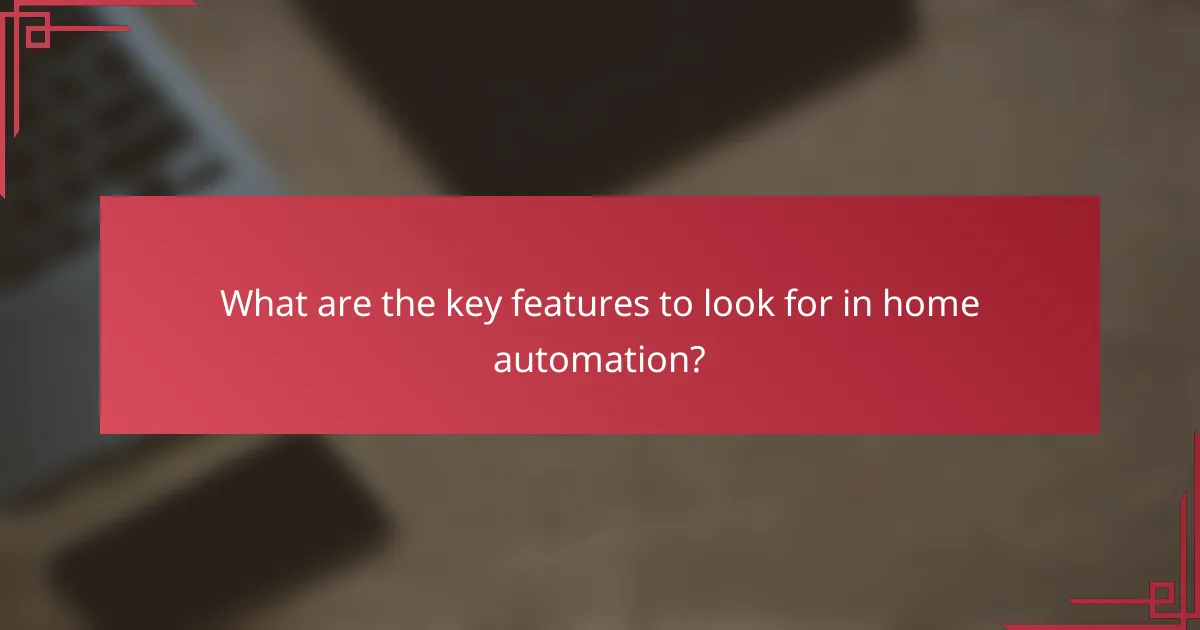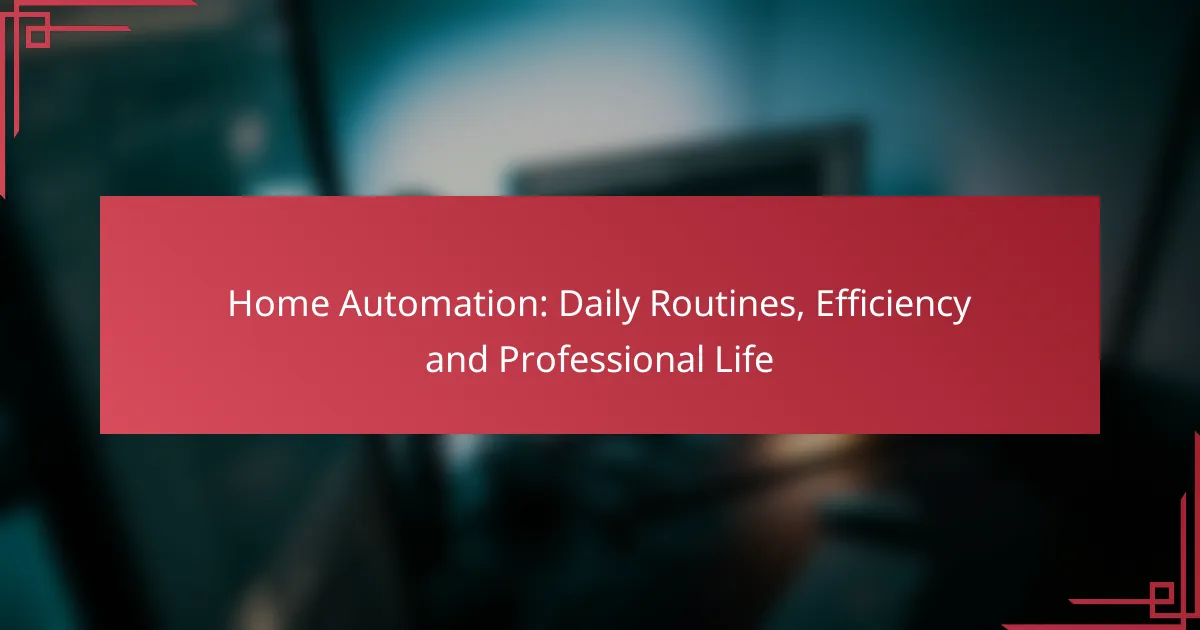Home automation offers a transformative approach to managing energy consumption and reducing costs for homeowners. By leveraging smart technology, systems can optimize energy usage, lower maintenance expenses, and ultimately enhance property value. This integration not only streamlines daily tasks but also contributes to significant long-term savings on utility bills.

How can home automation save costs in Ireland?
Home automation can significantly reduce costs in Ireland by optimizing energy usage, lowering maintenance expenses, and enhancing property value. By integrating smart technology, homeowners can achieve greater efficiency and long-term savings.
Reduced energy bills
Home automation systems can help lower energy bills by allowing homeowners to monitor and control energy consumption more effectively. Smart thermostats, for example, can adjust heating and cooling based on occupancy and preferences, potentially saving up to 20% on heating costs.
Additionally, automated lighting systems can turn off lights in unoccupied rooms, further reducing electricity usage. Many smart devices are designed to operate during off-peak hours, which can also lead to lower energy costs.
Lower maintenance costs
Automated home systems can help identify maintenance issues early, preventing costly repairs down the line. For instance, smart sensors can detect leaks or unusual temperature changes, alerting homeowners before problems escalate.
Regular maintenance reminders can be programmed into smart home systems, ensuring that essential tasks like HVAC servicing or filter changes are not overlooked. This proactive approach can save homeowners significant amounts on emergency repairs and replacements.
Increased property value
Investing in home automation can enhance property value, making homes more attractive to potential buyers. Features such as smart security systems, energy-efficient appliances, and integrated home management systems are increasingly sought after in the Irish real estate market.
Homes equipped with advanced technology often command higher prices and sell faster than those without. According to market trends, properties with smart home features can see a value increase of around 5-10%, depending on the local demand and the technology implemented.

What are the most efficient home automation systems?
The most efficient home automation systems streamline daily tasks, enhance energy savings, and improve overall convenience. Key players in this space include Google Nest, Amazon Echo, and Philips Hue, each offering unique features tailored to different needs.
Google Nest
Google Nest provides a comprehensive suite of smart home devices, including thermostats, cameras, and speakers, all integrated through the Google Home app. This system allows users to control their home environment efficiently, adjusting heating and cooling based on occupancy and preferences.
Consider the Nest Learning Thermostat, which learns your schedule and can save up to 15% on heating and cooling bills. Additionally, its compatibility with various smart devices makes it a versatile choice for home automation.
Amazon Echo
Amazon Echo serves as a hub for smart home devices, utilizing Alexa for voice control and automation. Users can manage lights, locks, and appliances through simple voice commands, making it user-friendly and accessible.
With features like routines, users can set multiple actions with a single command, such as turning off lights and locking doors at bedtime. The Echo’s integration with numerous third-party devices enhances its functionality, allowing for a tailored smart home experience.
Philips Hue
Philips Hue focuses on smart lighting solutions, offering a range of bulbs and fixtures that can be controlled remotely. Users can customize lighting settings, create schedules, and even sync lights with music or movies for an immersive experience.
These smart bulbs can lead to energy savings by allowing users to turn off lights remotely or set timers. Philips Hue also integrates with other smart home systems, making it a great addition for those looking to enhance their home automation setup.

How does home automation improve energy efficiency?
Home automation enhances energy efficiency by optimizing the use of energy-consuming devices through smart technology. By automating systems like heating, lighting, and monitoring energy usage, homeowners can significantly reduce waste and lower utility bills.
Smart thermostats
Smart thermostats adjust heating and cooling based on occupancy and preferences, leading to more efficient energy use. For example, they can lower the temperature when no one is home and warm up shortly before residents return, saving energy without sacrificing comfort.
Many models allow remote control via smartphone apps, enabling users to make adjustments on the go. Look for features like learning capabilities and integration with other smart home devices for maximum efficiency.
Automated lighting
Automated lighting systems can turn lights on and off based on occupancy or time of day, reducing unnecessary energy consumption. Motion sensors and timers are common features that help ensure lights are only used when needed.
Consider using LED bulbs with smart lighting systems for further energy savings. These bulbs consume less power and last longer than traditional incandescent options, enhancing the overall efficiency of your home lighting.
Energy monitoring systems
Energy monitoring systems track real-time energy usage, providing insights into which devices consume the most power. This information can help homeowners identify energy hogs and adjust usage patterns accordingly.
Some systems offer alerts for unusual energy spikes, allowing for proactive measures. Investing in a comprehensive energy monitoring system can lead to substantial savings by promoting more informed energy consumption habits.

What factors influence the cost of home automation?
The cost of home automation is influenced by several key factors, including system complexity, device compatibility, and installation fees. Understanding these elements can help homeowners make informed decisions and budget effectively for their automation projects.
System complexity
The complexity of a home automation system directly affects its cost. More advanced systems that integrate multiple functions—such as lighting, security, and climate control—tend to be pricier than simpler setups. For instance, a basic smart lighting system may cost a few hundred dollars, while a comprehensive home automation network could run into the thousands.
When considering system complexity, evaluate your specific needs and how much automation you truly require. A well-planned system can save money in the long run by enhancing efficiency and reducing energy costs.
Device compatibility
Device compatibility plays a crucial role in determining overall costs. Not all smart devices work seamlessly together, which can lead to additional expenses if you need to replace incompatible devices or purchase a central hub. For example, if you choose devices from different manufacturers, you may face integration challenges that could increase setup costs.
To minimize expenses, opt for devices that adhere to common standards like Z-Wave or Zigbee, which ensure better compatibility. Researching compatible devices before purchasing can help avoid costly mistakes.
Installation fees
Installation fees can significantly impact the total cost of a home automation system. Professional installation typically ranges from a few hundred to several thousand dollars, depending on the system’s complexity and the labor required. DIY installations can save money but may require technical skills and time.
When budgeting for installation, consider whether you will hire a professional or tackle the project yourself. If choosing a professional, obtain multiple quotes to ensure competitive pricing and check reviews for quality assurance.

What are the key features to look for in home automation?
Key features to consider in home automation include interoperability, user-friendly interfaces, and security features. These elements ensure that your system operates smoothly, is easy to use, and keeps your home safe.
Interoperability
Interoperability refers to the ability of different devices and systems to work together seamlessly. When selecting a home automation system, ensure it supports various protocols like Zigbee, Z-Wave, or Wi-Fi, allowing devices from different manufacturers to communicate effectively.
For example, a smart thermostat should be able to integrate with smart lights and security cameras. This compatibility enhances functionality and provides a cohesive user experience, making it easier to manage your home automation setup.
User-friendly interfaces
A user-friendly interface is crucial for effective home automation. Look for systems that offer intuitive apps or control panels, allowing you to easily manage devices from your smartphone or tablet.
Consider features like voice control and customizable dashboards that let you prioritize the devices you use most. A simple setup process and clear instructions can significantly reduce frustration and improve your overall experience.
Security features
Security features are essential in home automation to protect your devices and personal information. Look for systems that offer encryption, secure user authentication, and regular software updates to safeguard against vulnerabilities.
Additionally, consider devices with built-in security features, such as cameras with motion detection and alerts, which can provide real-time notifications. Ensuring your home automation system has robust security measures will help maintain your peace of mind.



